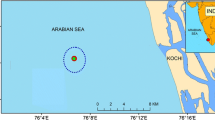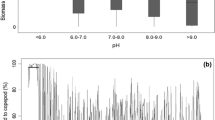Abstract
The algal biomass ingested by omnivorous cyclopoid copepods (Cyclops kolensis and C. vicinus) was measured by two methods in the hypertrophic Heiligensee in Berlin (West Germany). The clearance and ingestion rates inferred from measurements of natural populations of 14C labelled phytoplankton were compared with those obtained from chlorophyll a determinations using the presence/absence method (observed chlorophyll a content of natural lake phytoplankton with and without addition of cyclopoids). Both methods gave similar results. Nevertheless, the radio tracer method is preferred, mainly because the short feeding duration excludes high variations in both the food composition and food concentration that limit the presence/absence method.
Similar content being viewed by others
References
Adrian, R., 1988. Untersuchungen zur herbivoren und carnivoren Ernährungsweise von Cyclops kolensis und C. vicinus (Crustacea, Copedoda) PhD. Thesis, Fachbereich Biologie, Freie Universität Berlin.
Ausgewählte Methoden der Wasseruntersuchung, 1973. Bd. 1 Chemische, physikalische, elektrochemische Methoden. VEB Gustav Fischer Verlag, Jena.
Brandl, Z. & C. H. Fernando, 1978. Prey selection by the cyclopoid copepods Mesocyclops edax and Cyclops vicinus. Verh. Int. Ver. Limnol. 20: 2505–2510.
De Mott, W. R., 1989. The role of competition in zooplankton succession. In: Sommer, U. (ed.), Plankton Ecology. Succession in Plankton Communities. Brock/Springer Series in Contemporary Bioscience. Springer Verlag.
Gliwicz, Z. M. & J. Piganowska, 1989. The role of predation in zooplankton succession. In: Sommer, U. (ed.), Plankton Ecology. Succession in Plankton Communities. Brock/Springer Series in Contemporary Bioscience. Springer Verlag.
Gulati, R. D., 1978. The ecology of common planktonic crustacea of the freshwaters in the Netherlands. Hydrobiologia 59: 101–112.
Haney, J. F., 1973. An in situ examination of the grazing activities of natural zooplankton communities. Arch. Hydrobiol. 72: 87–132.
Haney, J. F. & D. J. Hall, 1975. Diel vertical migration and filter-feeding activities of Daphnia Arch. Hydrobiol. 75: 413–441.
Marker, A. E. H., Nusch, E. A., Rai, H. & B. Riemann, 1980. The measurement of photosynthetic pigments in freshwaters and standardization of methods: Conclusions and recommendations. Arch. Hydrobiol. Beih. Ergebn. Limnol. 14: 91–106.
Mischke, U., 1989. Untersuchungen zur Sedimentation im hypertrophen Heiligensee (Berlin West) während der Frühjahrsblüte und des Klarwasserstadiums 1987. Diplom Thesis, Department of Biology, Freie Universität Berlin.
Peters, R. H., 1984. Methods for the study of feeding, grazing and, assimilation by zooplankton. In: J. A. Downing & F. H. Rigler (eds), A manual on Methods for the Assessment of Secondary Productivity in Fresh Waters. IBP Handbook no. 17, Blackwell Scientific Publications, Oxford, London, Edinburgh, Boston, Melbourne, 2nd edn: 336–412.
Porter, K. G., 1976. Enhancement of algal growth and productivity by grazing zooplankton. Science 192: 1332–1333.
Rigler, F. H., 1971. Feeding rates. Zooplankton. In: Edmondson, W. T. & G. G. Winberg (eds), A Manual for the Assessment of Secondary Productivity in Freshwaters. IBP Handbook no. 17. Blackwell Scientific Publications, Oxford and: Edinburgh: 228–256.
Tackx, M. L. M. & E. M. van de Vrie, 1985. Calculations of results in grazing experiments using the counting method. Hydrobiol. Bull. 19: 29–36.
Thompson, J. M., Ferguson, A. J. D. & C. S. Reynolds, 1982. Natural filtration rates of zooplankton in a closed system: The derivation of a community grazing index. J. Plankton Res. 4: 545–560.
Tóth, L. G. & N. P. Zánkai, 1985. Feeding of Cyclops vicinus (Uljanin) (Copepoda: Cyclopoida) in Lake Balaton on the basis of gut content analyses. Hydrobiologia 122: 251–260.
Vanni, M. J., 1987. Effects of nutrients and zooplankton size on the structure of a phytoplankton community. Ecology 68: 624–635.
Zánkai, N. P., 1984. Predation of Cyclops vicinus (Copepoda: Cyclopoida) on small zooplankton animals in Lake Balaton (Hungary). Arch. Hydrobiol. 99: 360–378.
Zánkai, P. N., & J E. Ponyi, 1986. Composition, density and feeding of crustacean zooplankton community in a shallow, temperate lake (Lake Balaton, Hungary). Hydrobiologia 135: 131–147.
Author information
Authors and Affiliations
Rights and permissions
About this article
Cite this article
Adrian, R. Filtering and feeding rates of cyclopoid copepods feeding on phytoplankton. Hydrobiologia 210, 217–223 (1991). https://doi.org/10.1007/BF00034680
Received:
Revised:
Accepted:
Issue Date:
DOI: https://doi.org/10.1007/BF00034680




